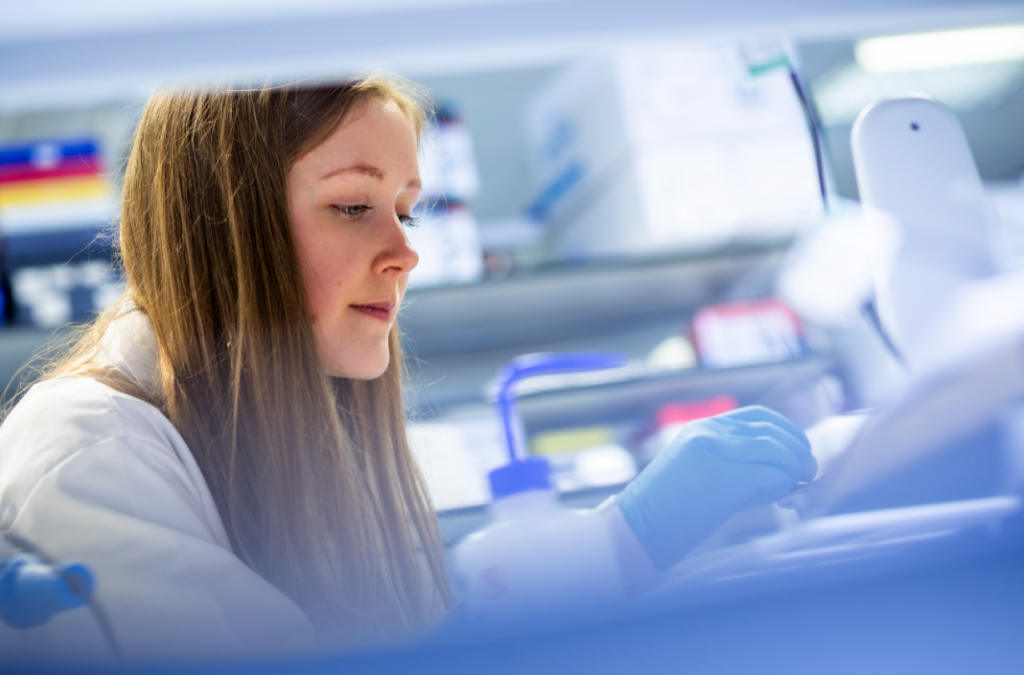What is MND
Find support
I have MND
I am supporting someone
Get involved
Research
About MND Scotland

Rob and his lab received £141,000 from MND Scotland in 2020 to help understand more about the mechanisms of MND and if a new biomarker for MND could be discovered. Now that his project is finished, we asked Rob to explain what a biomarker is, their importance in MND research, and what his next steps are.

I’m Professor Rob Layfield, a Biochemist at the University of Nottingham. I started my research career over 30 years ago, initially focused on mechanisms of neurodegeneration in Alzheimer’s and Parkinson’s disease. I have a long-standing research interest in cellular mechanisms of removal of defective ‘disease-associated’ proteins that cause neurodegeneration. About 10 years ago, my group began working in MND research and produced some of the first evidence that failure of the natural cellular ‘waste disposal’ system – called autophagy – might drive the changes seen in MND.
A biomarker is defined as a measurable sign of a biological condition or process. In the case of MND, we often think of a biomarker as some naturally occurring molecule, such as a protein or an RNA (a genetic messenger molecule) the levels of which tell us about disease stage, activity or how the body responds to a treatment. ‘Circulating biomarkers’ that are present in the blood are some of the most practically useful, as they can be measured relatively easily.
No single MND-specific molecular biomarker is in standard clinical use yet, but there is a huge amount of research going on. There is good progress in the field of MND protein biomarkers – neurofilament proteins and a protein called TDP43 – with a lot of activity also directed towards the identification of RNA biomarkers, in particular a class of these biomolecules called microRNAs. Probably we will end up with panels of multiple biomarkers, where their combined levels inform us about MND activity. Recent high-profile work in the Alzheimer’s field indicates some circulating protein biomarkers change more than 10 years before clinical diagnosis, giving us optimism that MND biomarkers will follow soon.
Biomarkers can allow for faster and more accurate diagnosis, bringing earlier access to care and support. They can provide clearer prognostic information, helping predict how MND may progress, allowing those living with MND and their families to plan ahead more effectively. Biomarkers can also tell us about disease mechanisms, helping us understand what’s driving MND at a molecular level, informing new hypotheses and targets.
As potential new treatments emerge, with better biomarkers more people could take part in clinical trials at earlier disease stages. This is when treatments might have the greatest effect and allow researchers to more precisely measure whether a treatment is working. In the future, biomarkers could help identify who is most likely to benefit from a new drug. MND is a heterogeneous disease, and biomarkers could help group people by underlying biology and disease mechanisms, paving the way for more targeted and personalised treatments, so people get the right treatments for their specific form of MND at the right time.
Our recent project focused on motor neurons, the key cells that malfunction in MND. Motor neurons naturally release very small balloon-like structures called ‘extracellular vesicles’ that are thought to act as packages that send messages to other cells. Extracellular vesicles are one source of circulating biomarkers in people living with MND. We investigated if MND-like genetic changes in motor neurons alter the messages, leading to the spread of “misinformation” to other cells. We found that healthy human motor neurons release proteins already known to be linked to MND in their extracellular vesicles, and some of these key proteins are lost when there are MND-like genetic changes (so represent potential biomarkers). We also found that the microRNAs signals are very different in extracellular vesicles released from motor neurons with MND-like genetic changes, suggesting that very different messages are being communicated to other cells.
Based on this research supported by MND Scotland, we are pleased to have secured £163,000 additional funding from the MND Association to focus on changes in microRNAs released by cells – motor neurons, but also extending to another important cell type called astrocytes – associated with a broader range of MND-like genetic changes. Preliminary results are very promising, with the dysfunctional cells seemingly releasing very different extracellular vesicles, with contents which we hope will direct the search for circulating (clinical) biomarkers. Our vision is to be able to use simple blood tests to monitor the health of different MND-associated cells – motor neurons and astrocytes – so that future treatment can be fine-tuned for the individual in response to disease activity, and treatment responses can be rapidly monitored.
MND Scotland would like to commend Professor Rob Layfield on his research, we are proud to have supported this work. We understand the importance of research into the mechanisms of MND and how improving our understanding of MND pathology will help identify potential targets and takes us closer to our vision of a world without motor neuron disease.
Sign up
for newsletter
Get the latest news and events straight to your inbox.
You can help create a world without MND